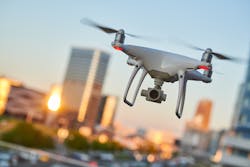Dedrone helps mitigate security risks in an expanding market
The advancement of drone technology, or unmanned air vehicles, over the last decade has been dynamic. The use cases are as diverse as the technology itself, with today’s drones being deployed in everything from disaster relief and delivery runs to video surveillance and robotic guards. But as ease of flying and cost-factors increase the deployment of drones, the security risks have also risen exponentially. As another cog along the IoT device network, drones are susceptible to hacks that can lead to unauthorized surveillance and even potential terrorism.
UAVs can be used to both protect and threaten airspace security in numerous ways. Safety and security drones are typically used for military and operational purposes, which saves the cost and time of field surveillance. Apart from this, drones are used in smart cities to maintain the safety and security of cities, monitor traffic, and provide an on-time response for emergency medical service. The global safety and security drones market was estimated to account for $354.8 million in 2019 and is expected to grow at a CAGR of 34.7 % over the forecasted period 2019-27, so says a recent market study.
SIW: End-users have found themselves in a paradigm shift as it relates to drone issues and business operations as use-case options increase. What were your clients and partners telling you that they need to provide solutions to the growing security mandates and risk mitigation challenges and how did you address these challenges?
Mary-Lou Smulders: When a person intrudes on a property, a security team may first locate and then apprehend the trespasser. With drones, this response becomes three-dimensional. Drone risk mitigation can be accomplished with smart airspace security in place, allowing security providers to look beyond the immediate yet illegal instinct to eliminate the threat by force, and instead turn to existing standard operating procedures (SOP’s) to address risk mitigation challenges and advance their response protocols before, during, and after a drone incursion.
Before a drone incursion, security teams can use Dedrone to identify likely take-off locations, hang no-fly-zone signs, and/or install cameras to deter potential pilots. During an active drone alert or incursion, security teams can monitor the drone and measure the time it would take for it to reach a critical point of interest, such as an airport runway, a data center cooling unit, or correctional facility’s recreation yard. Additionally, security teams can be deployed to follow the drone, and approach or apprehend pilot. Passive countermeasures can also be deployed, such as lowering blinds to prevent aerial espionage, monitoring Wi-Fi networks for intrusions, leading people away from open or exposed areas, or halting operations until the drone threat has been resolved.
After a drone incursion, security teams can use Dedrone data to make evidence-based decisions on how to expand security procedures throughout critical events. Laws for unauthorized drone flights at critical infrastructure, including airports, are growing around the world as well – with stiffer penalties. An essential detection requirement must include data logging for forensic evidence to be used by law enforcement, and in the event of damage, for insurance or legal prosecution.
SIW: What have been the most dynamic technology trends your product team has seen playing out this year and what long-term changes in drone security have advanced video analytics played in the expansion and upgrade of solution options?
Smulders: With the acceleration of drone-forward regulations, encouraging the productive use of drones (such as delivery, search and rescue, security), one of the most dynamic trends we are seeing is more organizations are integrating drones into their normal operations, and requiring airspace security which differentiates between the friendly, cooperative drones, and unauthorized or malicious drones. Another dynamic trend today that will continue into the years to come is through Remote ID and unmanned traffic management systems. Government-led Remote ID requirements for drones mandate drone pilots to equip their drones to emit registration data, flight details, drone, and pilot location. Smart airspace security integrates Remote ID information, as well as drone activity that is not registered through Remote ID, to provide a complete picture of all drones regardless of registration status.
Advanced video analytics is becoming a critical element. When a video is incorporated into an airspace security solution, users are able to visually confirm the presence of a drone, as well as observe the payload. Smart airspace security programs will automatically fuse data collected from foundational, radio frequency sensors, and use that data to track and protect points of interest with enhanced details on the drone target location, through Pan-Tilt-Zoom (PTZ) cameras. Once the PTZ cameras have detected the drones using external position information (e.g., RF sensors), they maintain the drone target tracking, even across varied backgrounds, including mountains and trees.
SIW: There seems to be a prior disconnect when it came to drone operations and security. Can you provide an overview that explains how things are trending differently now and what solutions, policies and regulations are filling in that risk gap?
Smulders: As the counter-drone market matures, more researchers and analysts are entering the conversation and providing analysis on the growth and predictions of mass adoption in the next 10-15 years. Laws on cUAS technology are evolving country-by-country, state-by-state, city-by-city. Forward-thinking security teams have begun to take a proactive approach to understand how many drones are in their airspace and how to prevent harm from an unwanted drone to people, property, and information. Ultimately, the only drone that matters is the one that a security team does not want in their airspace. Here is what we see trending:
- Evolving allowances for drone usage: U.S. federal regulators including the Federal Aviation Administration (FAA), Department of Homeland Security (DHS), and the Department of Defense (DoD) are continually evaluating and implementing new drone regulations, which support the safe integration of drones into the national airspace. Additionally, federal regulators and agencies support drone innovation and market growth by investing in U.S.-based drone companies, passing legislation to support drone use, such as Beyond Visual Line of Sight (BVLOS) and nighttime flying restrictions, and Operations Over People (OOP). Government regulators are engaging both drone and counter-drone companies to create complete unmanned traffic management frameworks, including the launch of Remote Identification systems.
- Remote ID in the U.S. and E.U.: Drone pilots in the U.S. and E.U. will be responsible for complying with drone regulations in their geography, including registering their aircraft and incorporating registration data into the drone’s Remote ID system. Using Dedrone, security providers will be able to read Remote ID data through Dedrone’s intelligent software system to identify the drone operator, operator’s location, drone type and drone location in real time. Dedrone’s proprietary database of drone activity, DedroneDNA, automatically references Remote ID data as well as identifies any unauthorized or noncompliant drone activity.
- Section 2209 of the FAA Extension, Safety, and Security Act of 2016: This will establish defined boundaries protecting “critical infrastructure” from unauthorized drones. According to the U.S. Chamber of Commerce Technology Engagement Center, Section 2209 requires the FAA to create a process enabling operators and proprietors of fixed-site facilities to apply for airspace restrictions or prohibitions to prevent UAS from operating in close proximity to their facilities. In the FAA Reauthorization Act of 2018, Congress directed the FAA to implement Section 2209 through a notice of proposed rulemaking (NPRM) by March 31, 2019, and issue a final rule within 12 months of publication of the proposed rule. To date, the FAA has not issued an NPRM implementing Section 2209. In the absence of the required rulemaking, many states have enacted legislation to protect critical infrastructure sites, resulting in a patchwork of state laws that could be confusing for critical infrastructure stakeholders and the UAS industry.
SIW: Please discuss what a malicious drone incursion to something as valuable as the critical infrastructure sector might look like and how it impacts business operations for companies and all sizes, and what are the options to mitigate this risk?
Smulders: While critical infrastructure sites are implementing drone surveying and inspection programs around the world, these organizations must also protect from unwanted drones. Drones pose a major threat to critical infrastructure because they could be used for industrial espionage or to damage a company's property, causing operational delays or shutdowns. Laws for unauthorized drone flights at critical infrastructure, including airports, are growing around the world – with stiffer penalties. An essential detection requirement must include data logging for forensic evidence to be used by law enforcement, and in the event of damage, for insurance or legal prosecution.
SIW: As you prepared for this ISC West event in 2021, what solutions is your company showcasing that might be new or simply a must-see for users and integrators?
Smulders: Airspace security is becoming a wide-scale, cooperative effort, with capabilities being launched globally such as Remote ID to monitor cooperative drone activity. Dedrone actively supports large-footprint organizations and local governments to detect, identify, locate, and mitigate their potential drone threats, with our latest software release, DedroneTracker 5.0
DedroneTracker 5.0 features advanced drone detection with greater accuracy and range through Time Difference of Arrival (TDoA) tracking. Ideal for urban deployments, the solution seamlessly communicates between sensors across widespread deployments. Dedrone’s 100% cloud-based offering is available for smart cities, and with DedroneTracker 5.0, cloud-based deployments efficiently communicate sensor data to identify drone activity and locate/track drones quickly. DedroneTracker is also available on-premise, as an air-gapped version.
Additionally, DedroneGuardian is now available for all security providers to access an all-in-one complete and integrated product line for total airspace security. Available either for fixed site deployments or as a mobile, rapid response model, DedroneGuardian provides security teams a quick-to-deploy, complete airspace security platform. For organizations ready to launch an entire drone detection and risk mitigation program, DedroneGuardian is the ideal solution.
About the Author
Steve Lasky
Editorial Director, Editor-in-Chief/Security Technology Executive
Steve Lasky is Editorial Director of the Endeavor Business Media Security Group, which includes SecurityInfoWatch.com, as well as Security Business, Security Technology Executive, and Locksmith Ledger magazines. He is also the host of the SecurityDNA podcast series. Reach him at [email protected].



